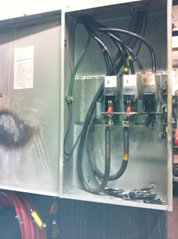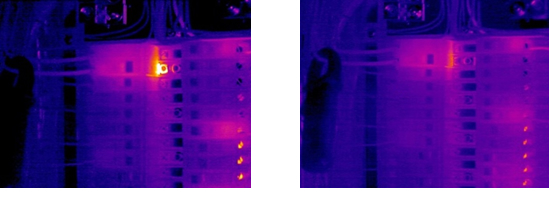Interesting Cases
Panel Cover Stories:
Is It OK to Scan an Electrical Panel Without Removing the Cover?
I’m amazed at how many infrared companies, or electrical contractors who use infrared technology, do not remove panel covers to perform inspections. Owners, maintenance personal, and even engineers have told me that previous companies doing infrared inspections would just open the panel door and scan the breakers to see if there were any hotspots. If a breaker showed up hot, they would then remove the cover to inspect further. Some even told me the inspectors had a “special camera” that could see through the panel like an x-ray. Unfortunately, that is not how the technology works.
The answer is “No, it is not ok to scan an electrical panel without removing the cover.” The only time a panel should be scanned without removing the cover is prior to the inspection. Upon entering an electrical room, a quick scan can be done of the electrical covers to see possible hazards before opening the equipment. If there is a major problem that is radiating heat through the cover, proceed with extreme caution.
 The picture to the right is of a 600amp disconnect feeding a large motor on a compressor. There was problem in the blade that had been documented the previous year, but had not been corrected. Thirty minutes before the thermographer was going to enter the room to perform the annual inspection, the blade failed and blasted the door open. In this case a quick scan of the cover could have revealed the problem lurking inside. The heat generated prior to this failure would have radiated to the cover and could have been detected before opening to do the proper inspection. Luckily no one was hurt. This is a good example of why PPE is so important when performing these types of inspections. It also demonstrates why it is important for owners, engineers, or maintenance personnel to correct the problems that are found by the infrared inspection company.
The picture to the right is of a 600amp disconnect feeding a large motor on a compressor. There was problem in the blade that had been documented the previous year, but had not been corrected. Thirty minutes before the thermographer was going to enter the room to perform the annual inspection, the blade failed and blasted the door open. In this case a quick scan of the cover could have revealed the problem lurking inside. The heat generated prior to this failure would have radiated to the cover and could have been detected before opening to do the proper inspection. Luckily no one was hurt. This is a good example of why PPE is so important when performing these types of inspections. It also demonstrates why it is important for owners, engineers, or maintenance personnel to correct the problems that are found by the infrared inspection company.
If an Infrared Inspection Company or Electrical Contractor perform a thermal scan of your facility and do not open all electrical equipment that is accessible, they are leaving possible critical problems behind. When performing an infrared scan on electrical equipment, it’s essential to remove all covers and dead fronts to expose energized parts. Any accessible connection points must be exposed in order to scan for possible thermal problems (anomalies). A good thermographer will not only look for thermal problems, but will also look for visual problems as well. This includes any NEC or OSHA violations of wrong wire size, grounding issues, burned / damaged wires, corrosion, missing knockouts and covers, and any other safety concerns.
Below is a picture of damaged insulation from a sharp edge on the back of a panel cover. If left uncorrected, eventually the copper in the wire would have made contact with the panel cover and resulted in a large arch flash. This problem would not have shown up with infrared, but a good inspector would have caught it. Again, without removing the panel cover this would have gone undetected.

The picture below is of a 480volt electrical panel that was scanned without removing the panel cover or dead front. This scan gives no indication of a problem with this panel. The heat generated in the breakers is due to normal load. A company not removing the covers and simply scanning the breakers, would have seen the infrared image below and see no reason to investigate further before moving on to the next piece of equipment.

The picture above is of the same 480volt panel with the cover and dead front removed exposing all the connection points. The 3 pole bolt on breaker had a line side problem on the C phase. The problem was due to either a loose connection or a cross threaded screw. The reason this problem did not show up with the cover in place was that the distance from the source of the problem to the dead front was nearly three inches. That air gap would not allow the thermal energy to radiate through and cause a heat signature on the cover to indicate that there was a problem.
Below is another example of a 208volt panel with the cover removed but not the dead front. Looking at the image on the left you would think the bottom right corner breaker had a problem. That breaker had a load of 15 amps and was rated for 20 amps. The heat generated is acceptable due to the load. In the picture to the right you can see the problem was actually the top 2-pole bolt on breaker. It was a 20 amp rated breaker and had a load of only 3 amps. The issue again was a simple loose connection, but would have been missed without removing all covers and exposing all connections.

The infrared images below are close-up of the same panel above. The breaker was feeding an important UPS system. The connection was properly tightened and the image to the right shows it was corrected.

These are just a few good examples of why it is important to remove all panel covers. Simply flying through a facility to find a handful of problems is just plain lazy. Our job as thermographers and inspectors is to properly identify any thermal problems or hazards for our customers.
No one enjoys removing panels, but it is a must. All connection points must be exposed to do a detailed inspection. Vibrations, temperature changes, and load variations over time can work connections loose. Harsh environments can cause corrosion. Poor installations with untightened or cross threaded connections and wires left behind fasteners and sharp edges can go undetected for years and then suddenly fail.
To put things in perspective, NFPA 1 (National Fire Code) recommends inspecting a fire extinguisher monthly to ensure proper working condition. An infrared electrical inspection is only recommended annually to ensure the electrical system is operating properly, safely, and efficiently. If infrared inspections are correctly carried out, including removing all covers, you might not need that monthly inspected fire extinguisher to put out an electrical fire.
Shawn Phillips
President
Infrared Guys, Inc.